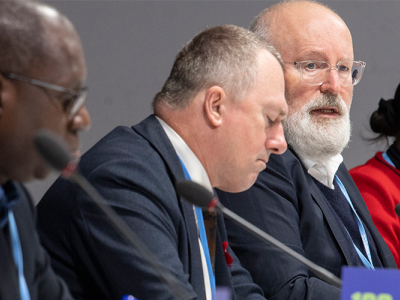
How to Harness the Global Capital Markets for the Sustainable Development Goals
The purpose of this article, and the full report(1) on which it is based, is to provide those involved in policy making with specific suggestions as to how they can move the capital markets onto a more sustainable basis. Adopting the conventional definition of sustainable development, we are seeking to promote: capital markets that finance development that meets the need of the present, without compromising the ability of future generations to meet their own needs (adapted from Brundtland, 1987, p43). This is an important concept for investors as development that provides short term benefits but creates significant costs over the long term can reduce the absolute value of long term investment portfolios.
Public policy makers have traditionally tended to focus on the flow of aid when considering traditional sustainable development issues. However, we believe that considering how the hundreds of trillions of private capital are allocated matters far more than how the tens of billions of dollars of official assistance get dispensed.
We see the primary failure of the capital markets in relation to sustainable development as one of misallocation of capital. This, in turn, is a result of global governments’ failure to properly internalise environmental and social costs into companies’ profit and loss statements. As a consequence, the capital markets do not incorporate companies’ full social and environmental costs. Indeed, until these market failures are corrected through government intervention of some kind, it would be irrational for investors to incorporate such costs since they do not affect financial figures and appear on the balance sheet or – therefore - affect companies’ profitability. This means that corporate cost of capital does not reflect the sustainability of the firm. The consequences of this are that unsustainable companies have a lower cost of capital than they should and so are more likely to be financed than sustainable companies.
We believe that policy makers need to both change the pricing signals within the market and improve the readiness of the supply chain of capital to integrate sustainability issues. This involves moving all participants towards a longer-term perspective when investing and exerting their influence as company owners. This requires an understanding of the role of institutions at each stage of the capital supply chain and a clear vision of how this stage should integrate sustainability issues within its operations. Put simply, policy makers need to improve the profitability of sustainable businesses relative to unsustainable ones. They also need to improve the ability of all key market participants to integrate these signals. We provide a few suggestions as to how this can be achieved.
The structure of capital markets
To help picture the capital markets, consider Figure 1. This depicts the relationship between the financial institutions that operate the market between the demand for and supply of capital in the equity markets. The different roles of the financial institutions are important as each role reflects the nature of the influence.
Figure 1: The structure of the equity capital market
Figure 1 is a simplifying model of the equity capital market and is intended to demonstrate how the various capital market institutions relate to each other. Put simply, money flows from the individuals on the right hand side into companies on the left hand side, which put the capital to work in different ways to generate a return on investment for their shareholders. These individuals may invest alongside others as institutional investors - such as pension schemes, insurance companies, or sovereign wealth funds – or as individual investors through retail financial advisors.
In many developed markets, institutional asset owners take the advice of investment consultants who, in turn, recommend which asset manager to choose. Such asset managers are also referred to as buy-side fund managers, and they buy shares from brokers on stock exchanges. Sell-side brokers are typically part of an investment bank. Such brokers provide investment analysis and recommendations to fund managers. They also act as market intermediaries, helping those fund managers that want to buy and sell securities. Some brokers will also be the prime broker for a company. Where this is the case, they will also advise the company on their capital structure and underwrite the issuance of new equities to the market.
Corporate debt is also traded in a similar way, although it tends to be conducted between fund managers and brokers, without the use of stock exchanges.
Of course, while company workers are highlighted as working for companies, they are also in many cases the providers of capital. So, in this sense the flow of capital can be thought of as circular.
Towards SDGs that secure capital market support
Our specific Sustainable Development Goals (SDG) proposals are based on our analysis of the structural weaknesses in the capital markets descried above, and are presented below according to the relevant thematic areas used by the SDGs Open Working Group(2) and are as follows:
“Goal: A resilient, sustainable economy that optimises quality of life for all”
Targets: Economic growth
- Develop SDG capital raising plans: for all Governments to develop national capital raising plans covering how they intend to finance the delivery of a zero-carbon economy and the Sustainable Development Goals; and for these national plans to be coordinated at the international level by the UN and World Bank. These will include a view on the money that can be raised via infrastructure investment, project finance, corporate debt, foreign direct investment, equity investment and sovereign and Multilateral Development Banks debt (see Figure 1);
- Establish integrated incentives: Governments to promote financial incentives along the investment chain that are fully aligned with long-term sustainable performance. This could involve reshaping the structure of individual remuneration along the capital supply chain;
- Promote integrated financial regulation: Governments to promote capital markets regulation that integrates sustainable development factors in the mandates of the supervision agencies of stewardship codes, listing rules and financial stability;*
“Sustainable Consumption and Production (of financial services)”
- Improve integrated financial literacy of the consumers and producers of financial services: Governments to have integrated sustainable finance into their national curricula by 2020; for the top fund manager and analyst courses such as the Chartered Financial Analyst Institute(3)> and for all the top MBA programmes to cover sustainable finance;
- Ensure integrated asset ownership: Governments to ensure all asset owners(4) with more than US$1 billion under management publish a report to the beneficial owners and society on how they have integrated sustainability considerations into their investment management agreements, or to explain why they have not done so;
- Ensure integrated investment consulting: Governments to require all investment consultants advising on more than US$10 billion in assets under management (AUM) to include a report to their clients and society on how well they think their fund managers are integrating sustainability, or to explain why they have not done so;
- Develop integrated asset management: Governments to require on a comply or explain basis all fund managers with more than US$10 billion under management to publish an integrated report for their asset owning clients and society by 2030, including details of how they have integrated sustainable development into all Annual General Meeting (AGM) voting, or to explain why they have not done so;
- Ensure integrated corporate brokerage: Governments to require all investment banks to have considered corporate performance on sustainability into all their recommendations to investors and advice to companies, or to explain why they have not done so;
“Good Governance and Capable Institutions”
- Improve integrated corporate governance: Governments to ensure all national corporate governance codes promote integrated corporate governance – i.e. corporate governance that integrates sustainable development;
- Improve integrated reporting by companies, investment banks, stock exchanges, asset managers, investment consultants, asset owners and proxy voting agencies: Governments to establish a national legislative framework requiring participants in the capital market supply chain to produce an integrated sustainability report to society – on a mandatory comply or explain basis;*
- Improve integrated proxy voting: Governments to call for proxy advisers(5) to integrate corporate sustainability performance into their advice to asset managers and asset owners on director (re)election, directors’ remuneration, and the quality of corporate integrated reports, or to explain why they have not done so;
- Establish integrated investment legal duties: for long-term sustainable development to be incorporated into the legal duties of market participants including, in particular, their fiduciary duty and duty of care of asset managers and investment consultants;
The above systemic interventions will work in concert, reinforcing each other and ensuring continuity throughout the capital supply chain.
Financing the future we want
Global capital markets should be among the primary facilitators of a sustainable global economy. Indeed, the creativity, entrepreneurship and innovation funded by capital markets should be the driving force behind a globally green and just economy. Fortunately, sustainable development issues do not arise from a lack of financial capital, as the markets have the financial firepower to deal with them now. They arise from the mispricing of sustainability issues and the ensuing misallocation of capital.
We need policy makers to work on the price signals and internalise corporate externalities onto company accounts via, for example, increased use of fiscal measures, standards and market mechanisms. We believe that it is well within the collective ability of our governments to ensure that capital markets enhance corporate sustainability and promote long-term business behaviour. They will need to deliver integrated reporting and require responsible investment. This will help resolve the underlying problems associated with unsustainable development that have been set out within the SDG process. It will also promote financial stability and long term economic growth.
Dr. Steve Waygood is Chief Responsible Investment Officer at Aviva Investors.
Footnotes
[1] This article is an extract from an Aviva White Paper "A Roadmap to Sustainable Capital Markets: How can the UN Sustainable Development Goals harness the global capital market?", available at www.aviva.com/roadmap
[2] Brundtland, G.H., Our Common Future, World Commission on Environment and Development, 1987.
[4] Following a round table discussion with a group of sustainable finance experts, this proposal and the one related to footnote 7, were regarded to be the two key next steps for policy makers that are seeking to integrate sustainability into sustainable capital markets.
[6] Such as pensions, insurance companies, foundations and sovereign wealth funds.
[7] Following a round table discussion with a group of sustainable finance experts, this proposal and the one above were regarded to be the two key next steps for policy makers that are seeking to integrate sustainability into sustainable capital markets.
[8] Proxy advisors produce recommendations for fund managers in relation to how to vote their shares at company AGMs.
This article was published in GREAT insights Volume 3, Issue 8 (September 2014).


